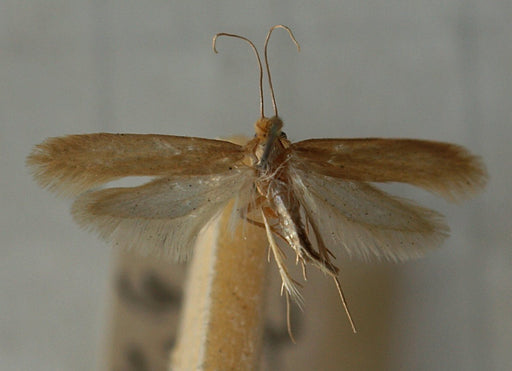The Webbing Clothes Moth - A Homeowners Guide
 Sarefo, CC BY-SA 3.0, via Wikimedia Commons
Sarefo, CC BY-SA 3.0, via Wikimedia Commons
The Webbing Clothes Moth (Tineola bisselliella) is also known as the Common Clothes Moth or simply Clothing Moth.
The caterpillars of this moth are considered a serious pest, as they can derive nourishment from clothing – in particular wool, but many other natural fibers – and also, like most related species, from stored food.
 Olaf Leillinger, CC BY-SA 2.5, via Wikimedia Commons
Olaf Leillinger, CC BY-SA 2.5, via Wikimedia Commons
This moth prefers moist conditions, although low humidity will merely slow development. Webbing Clothes Moths are small moths whose adults grow to between 1 and 2 cm in length. Their eggs are tiny, most being under 1 mm long and barely visible. A female will lay several hundred during her lifetime; egg placement is carefully chosen in locations where they will have the best chance for survival.
The eggs are attached with a glue-like substance and can be quite difficult to remove. After the egg hatches, the clothes moth larva will immediately look for food. Clothes moth larvae can obtain their required food within two months, but if conditions are unfavorable they will feed intermittently for a long time. Whether it takes two months or two years, each larva will eventually spin a cocoon in which it will pupate and change into an adult webbing clothes moth. Clothes moth larvae stay in these cocoons for between one and two months and then emerge as adults ready to mate and to lay eggs.
This species is notorious for feeding on clothing and natural fibers; they have the ability to turn keratin (a protein of which hair and wool mainly consist) into their food. The moths prefer dirty materials and are especially attracted to carpeting and clothing that contains sweat or other liquids that have been spilled onto them. They are attracted to these areas not for the food but for the moisture imparted to the fabric: the clothes moth caterpillars do not drink water; consequently their food must contain moisture.
Adult clothing moths and their larvae prefer low light conditions. Unlike many other moths, which are drawn to light, Clothes Moths seem to prefer dim or dark areas. Handmade rugs are a particular favorite, because it is easy for the larvae to crawl underneath and do their damage from below. The clothes moth larvae will also crawl under baseboards in search of darkened areas where debris has gathered and which consequently hold good food.
 Guido Gerding, CC BY-SA 3.0, via Wikimedia Commons
Guido Gerding, CC BY-SA 3.0, via Wikimedia Commons
The eggs hatch into moth larvae, which then begin to feed. Once they have completed their larval development, the clothes moth larvae pupate and after metamorphosis emerge as adult clothes moths. Adults do not eat; males clothes moths look for females with whom to mate, and females look for places to lay their eggs. Once the reproduction is complete, the adult clothes moths die. Contrary to what most people believe, adult moths do not eat or cause any damage to clothing or fabric. It is the clothes moth larvae which are solely responsible for damage to clothing and carpets, and which spend their entire time eating and foraging for food.
Pest control
Control measures for Clothes Moths include the following:
Physical measures
- Webbing Clothes Moth Traps – this step can help monitor the current infestation and catch the males therefore preventing them from mating with females
- Dry cleaning – kills moths on existing clothing and helps remove moisture from clothes
- Freezing – Freezing the clothing for several days at temperatures below 0 °C
- Heat (49 °C for 30 minutes or more) – these conditions may possibly be achieved by placing infested materials in an attic in warm weather, or by washing clothes at or above this temperature. Specialist pest controllers can also provide various methods of heat treatment.
- Sunlight – has a limited effect in dealing with clothes moths issues once the clothes moth larvae are established
- Vacuuming and general cleaning / airing of carpets and clothes – Since the moths like to hide in carpeting and skirting boards, this is a part of the process in achieving total eradication of clothes moths and their larvae
Mothproofing
- Treatment of clothing and carpets as a preventive measure before their use, as well as simply for storage, has a long history and conventional (toxic and carcinogenic) moth balls were a traditional solution
- For larger infestations you may like read our Clothes Moths Kit Guide and Carpet Moths Kit Guide for further information on how to eradicate moths using chemical treatments in line with our Traps.
- Natural scented deterrents such as cedar and lavender are popular particularly if you prefer not to use chemical products.
Webbing Clothes Moth Identification, Prevention, and FAQs
No question about it, Webbing Clothes Moths are real pests and you certainly don’t want them in your house. Therefore, you will want to know what steps to take toward preventing and eradicating them. With the proper knowledge and skills, you can keep your silk, cashmere, wool, and leather safe from these pesky insects.
Signs of Clothes Moths: Clothes Moth Webbing, Casings, Cocoons, and Larvae
Although Webbing Clothes Moths may get into your house without your knowledge or consent, once they start infesting your wardrobe, they are likely to leave behind plenty of evidence. From holes in your clothes to larvae and cocoons, the Webbing Clothes Moth is not a subtle houseguest.
Indeed, there are many ways to tell if you have a Clothes Moth infestation. Let’s discuss how to identify the Webbing Clothes Moth at every lifecycle stage to ensure that your favorite outfits are kept safe and sound!
Recognizing and Eradicating Webbing Clothes Moth Larvae
Webbing Clothes Moth Larvae start out small and are at first a yellowish-white color. Over time, they grow larger and take on a brown or tannish color. Webbing Clothes Moth Larvae often have heads that are a slightly darker color than their bodies. Expect the larvae of the Webbing Clothes Moth to measure about ¼ of an inch in length.
Webbing Clothes Moth Larvae Behavior
Immediately after hatching, Webbing Clothes Moth Larvae begin chewing through the nearest food source (which may be your clothing, decor, or furniture). Usually, they take a couple of months to grow to their largest size, spin cocoons, and complete metamorphosis.
However, if temperatures are colder this will slow down the metamorphosis into the adult stage, so things may take much longer. This means more damage to your belongings could take place. It is essential to identify and eradicate Webbing Clothes Moth Larvae as expediently as possible if you believe you have noticed signs of these pests.
Signs of Webbing Clothes Moth Larvae may include:
- Holes in natural fabrics
- Dead larvae
- Cocoons
- web-like substances in corners or crevices
Identifying a Webbing Clothes Moth Cocoon
Depending on what the weather conditions are like in your area, Webbing Clothes Moth Larvae can take months or much longer to spin cocoons. These cocoons are small and light tan in color. Usually, they will be attached to a surface by a sticky "web" substance. Removing cocoons before the moths can emerge may prevent further damage to your clothes or fabrics.
Removing Webbing Clothes Moth Eggs from Clothes and Furniture
The eggs of the Webbing Clothes Moth are very small and nearly invisible to the naked eye. As such, they can be easily concealed in the crevices of furniture, attached to hard-to-see surface areas via a sticky, glue-like substance. To prevent infestations, it is important to treat any items that you get second-hand before bringing them into your home.
To kill hidden Webbing Clothes Moth Eggs, place items that cannot be washed on a high temperature in the freezer for 72 hours. To monitor for Clothes Moths we recommend the purchase of our Clothes Moth Traps for Wool Moths which will help break the breeding cycle by attracting the adult male moths. For a larger infestation you may like to read our Clothes Moth Kit Guide for information on how to use chemical products in line with our Traps to rid your home of Clothes Moths.
How do I get rid of Webbing Clothes Moth?
To get rid of Webbing Clothes Moths, start with prevention. Always be “moth aware” and inspect used furniture or clothes for signs of moth damage (or eggs) before bringing them into your home. If you suspect an infestation, freeze clothing or decor items for 72 hours to kill any hidden eggs.
If you notice signs of Webbing Clothes Moths in your home, remove all infested fabric items and freeze or launder/dry clean them. Then, clean the infested area thoroughly. After you have removed any adult moths, larvae, and eggs, use moth-repellent sachets and Moth Traps to prevent a recurring infestation. Cedar shelving may also help to keep these moths from making a home in your closet.
Where do webbing clothes moths come from?
These moths can be found infesting upholstered furniture (on the inside and outside), and in ducts or vents where the larvae can feed on any shed pet hair, lint, dust, and other bits of debris. Infestations may also stem from animal carcasses or bird nests in attics, walls, or chimneys.
Webbing Clothes Moths live in the United States, Canada, Europe, and many other places around the world. They enter homes in a few ways including flying through open windows or by hitching a ride on used clothing or furniture items. Eggs can be hard to see and are often attached in crevices or other hard-to-pinpoint places.
What does clothes moth webbing look like?
Webbing Clothes Moths are small and tan, beige, or brown with heads that are slightly darker than their bodies. Their wings are not decorative and are often slightly frayed at the edge.
Are webbing clothes moths attracted to light?
The Webbing Clothes Moth (Tineola bisselliella) does not fly strongly. These moths are NOT attracted to light. Instead, they prefer dark, secluded areas where they can hide out and lay their eggs. Clothes Moth Larvae also avoid light and dwell in secluded areas away from light.
About MothPrevention
MothPrevention® speak to customers every day about their clothes moth issues - clothes moths are a species that are ever increasing and that can cause significant damage to clothes, carpets and other home textiles.
To date, we’ve helped over 250,000 customers deal with their moth problems. We have developed professional grade solutions including proprietary pheromones and trap design, not available from anybody else in the USA.





